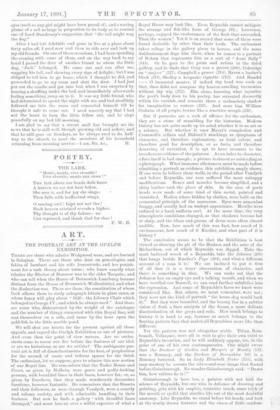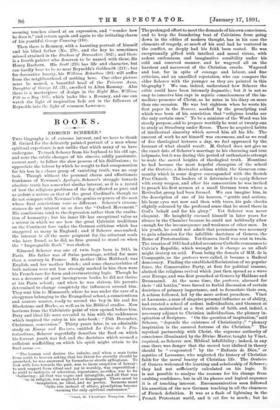ART.
THE PORTRAIT ART AT THE GUELPH EXHIBITION.
THERE are those who admire Wedgwood ware, and are learned in Salopian. There are those who doat on genealogies, and fables of Isenbart and his wife Irmentrude, and her punish- ment for a rash theory about twins ; who know exactly what relative the Elector of Hanover was to the elder Tarquin ; and who can tell when the House of Brunswick-Luneburg became distinct from the House of Brunswiek-Wolfenbiittel, and what the distinction was. There are those, the constitution of whose back allows them to study autograph letters in glass oases, or whose fancy will play about " 1626: the Library Chair which belonged to George IV., and which he always used." And there are some who, dieheartened by the weight of the catalogue and the number of things connected with this Royal line, will :seat themselves on a sofa, and muse by the hour upon the gold-fish in the little marble pond.
We will shut our hearts for the present against all those :appeals, and regard the Guelph Exhibition as one of pictures. And even then the point of view wavers. Are we enthu- siasts come to nurse our fire before the features of our idol, or are we historians, or are we artists ? The ambiguous por- trait art is full of disenchantments for the first, of perplexities for the second`, of waste and tedious spaces for the third. The enthusiast, let us suppose, goes to admire this new section of our Royal line. He remembers that the Tudor House and Court, as given by Holbein, were grave and godly-looking persons, with beautiful lines in their faces, however fat; or, as given by Zucchero, that they made wondrously decorative furniture, however fantastic. He remembers that the Stuarts and their followers, as seen through Vandyck, were a courtly and solemn society, and with admirable handling in their features. But now he finds a gallery " with dreadful faces thronged," and must lament over a wilful exposure of what a Royal House may look like. Even Reynolds cannot mitigate the strange and fish-like form of George III.; Lawrence, perhaps, enjoyed the exuberances of the flesh that succeeded. Then the women ! Yet it is on record that some of them were found desirable by other than their lords. The enthusiast takes refuge in the gallery given to heroes, and the same disillusionment dogs him there, when he conies to a portrait of Nelson that represents him as a sort of " Aunt Sally " (144). Or he goes to the poets and artists in the third gallery, and he finds that Gray was a parrot (206), Coleridge an " orajeet " (227), Campbell a grocer (214), Byron a barber's block (213), Shelley a keepsake vignette (212). And Handel — 0 immortal master, if indeed thy head was such as that, thou didst not compose thy heaven-assailing harmonies without thy wig (272). Elia alone, knowing what injustice the poet's body does to his poetry, has retreated discreetly within his varnish, and remains there a melancholy shadow for imagination to restore (223). And near him William Godwin, of all people, beams like a sensitive seraph (230).
But if portraits are a rock of offence for the enthusiast, they are a stone of stumbling for the historian. Modern history has not quite made up its mind whether it is an art or a science. But whether it uses Marat's complexion and Cromwell's collars and Diderot's stockings as symptoms of character, and therefore explanatory, as local colour, and therefore good for description, or as facts, and therefore deserving of narration, it is apt to have recourse to the treacherous evidence of the painters. As an index to character, a face itself is bad enough ; a picture is almost as misleading as a photograph. What immense allowances must be made before admitting a portrait as evidence, this exhibition amply shows. If one were to believe these walls, in the period after Vandyck and before Reynolds, our race suffered the most unhappy modifications. Bones and muscles became simplified, and a . shiny leather took the place of skin. In the case of poets heads were made of some kind of thin metal, painted and varnished. Bodies, where hidden by clothes, were built on the economical principle of the scarecrow. Eyes were somewhat froggy, and 'usually had an unslept appearance. Mouths were reduced to a hard, uniform curl. At the same time, the very atmospheric conditions changed, so that shadows became hot or slaty, and the blues and greens of dress were often almost audible. Now, how much of this was fact, how much of it environment, how much of it Kneller, and what part of it is history ?
The conclusion seems to be that the Exhibition is best viewed as showing the pit of the Hudson and the mire of the Richardson, out of which Reynolds was digged. Take the most bettered wreck of a Reynolds, take the Johnson (205) that hangs beside Kneller's Pope (204), and what a different account of a man it is ! We are inclined to put it first of all that it is a truer observation of character, and there is something in that. We can make out that the Johnson has an angry eye and a talking mouth, and when we have recalled our Boswell, we can read further subtleties into the expression. And some of Reynolds's faces we know were considered like. But others, we must remember, were not ; they were not the kind of portrait " the house-dog would bark at." But they were beautiful, and the beauty lies in a subtler vision of flesh, a finer analysis of the forms, a more delicate discrimination of the greys and reds. How much belongs to history it is hard to say, because so much belongs to the floating pattern face that makes all Reynoldses more like than different.
Yet the pattern was not altogether stable. Titian, Rem- brandt, Velasquez, were all in wait to give their own twist to Reynolds's invention, and he will suddenly appear, too, in the guise of one of his own contemporaries. One might swear that the Duchess of Gordon and Marquis of Huntly (131) was a Romney, and the Duchess of Devonshire (93) is a Romney bettered. So in Lady Elizabeth Foster (155), with easy mastery he arrests the silver-and-rose image that floated before Gainsborough. No wonder Gainsborough said : " Damn him, how various he is !"
Gainsborough is here too, a painter with not half the science of Reynolds, but one who, in defiance of drawing and painting, gets with his empiric, tentative touch, some trick of the mouth or eyelid that startles life out of the most doubtful anatomy. Like Reynolds, we stand before his heads, and look at the neatly drawn features and the chaos of little random- seeming touches aimed at an expression, and "wonder how he does it," and return again and again to the irritating charm of his youthful George Canning (110).
Then there is Romney, with a haunting portrait of himself and his blind father (No. 270), and the key he sometimes missed attained in the Duchess of Devonshire (162) ; and there is a fourth painter who deserves to be named with these, Sir Henry Raeburn. His Scott (215) has life and character, but can hardly bear to be so near Reynolds's Goldsmith (211); but for decorative beauty, his William Robertson (201) will suffer from the neighbourhood of nothing here. One other picture must be named, a beautiful head of the Princess Anne, Daughter of George II. (31), ascribed to Allan Ramsay. Also there is a masterpiece of design in the Right Hon. William Pitt as a Boy (105). which looks like a Romney, and one can watch the light of inspiration fade out in the followers of Reynolds into the light of common Lawrence.







































 Previous page
Previous page